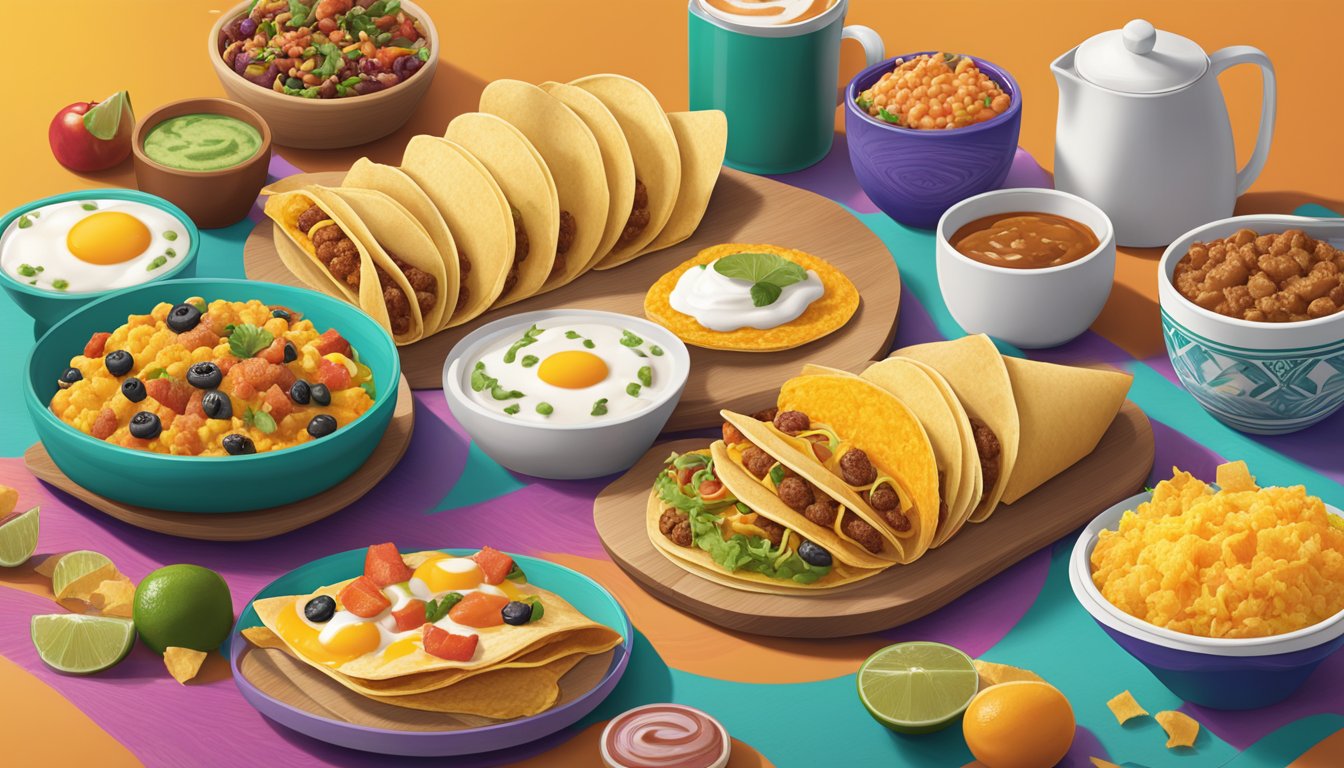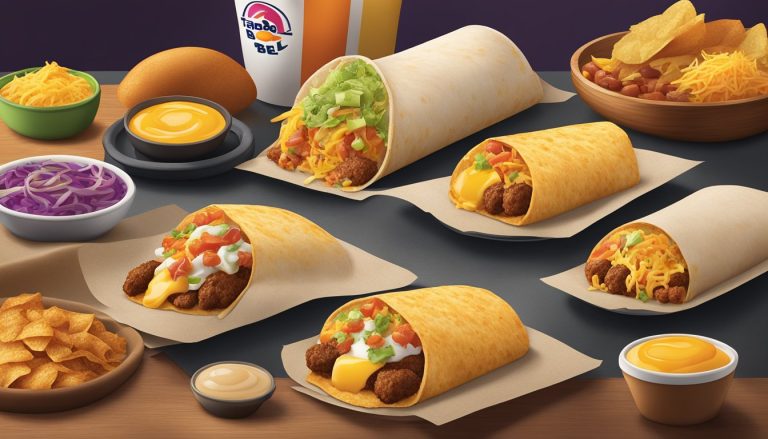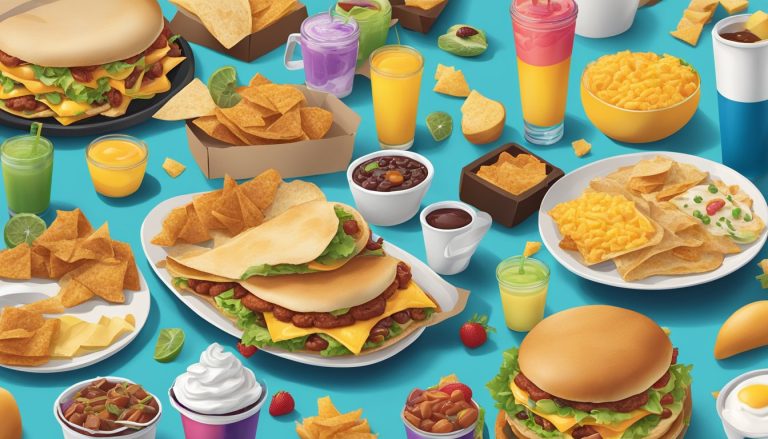Taco Bell’s breakfast menu reflects a unique blend of Mexican-inspired flavors and American fast-food convenience. The chain’s morning offerings showcase a fusion of traditional Mexican ingredients with familiar breakfast staples, creating a distinctive Tex-Mex breakfast experience.
Taco Bell’s breakfast innovations have popularized Mexican-inspired morning meals, making them accessible to a wider audience across the United States. The introduction of breakfast burritos, a cornerstone of their morning menu, exemplifies this cultural fusion. These portable meals combine scrambled eggs, cheese, and various meats with elements reminiscent of Mexican cuisine, such as salsa and tortillas.
While not considered authentic Mexican food, Taco Bell’s breakfast items serve as an entry point for many consumers to explore Mexican-inspired flavors. The chain’s success in the breakfast market demonstrates the growing appeal of diverse culinary influences in American fast-food culture.
Historical Context of Taco Bell
Taco Bell’s origins and menu evolution reflect its fusion of Mexican-inspired cuisine with American fast-food sensibilities. The chain’s growth from a single location to a global brand demonstrates its impact on popularizing Tex-Mex flavors.
Origins of Taco Bell
Glen Bell founded Taco Bell in 1962 in Downey, California. His inspiration came from Mexican restaurants in San Bernardino, where he was stationed during military service. Bell’s first 400-square-foot restaurant offered a simple menu of five items: tacos, burritos, frijoles, chiliburgers, and tostadas.
The concept quickly gained popularity. Bell’s innovative approach to Mexican-inspired fast food resonated with American consumers. Within two years, Taco Bell expanded to eight locations in the Los Angeles area.
By 1967, the company had grown to 100 restaurants. This rapid expansion set the stage for Taco Bell’s transformation into a national brand.
Evolution of the Taco Bell Menu
Taco Bell’s menu has undergone significant changes since its inception. The original offerings focused on basic Mexican-inspired dishes adapted for American tastes.
In the 1970s and 1980s, Taco Bell introduced new items to broaden its appeal:
- Enchiritos (1970)
- Bell Beefers (1975)
- Cinnamon Crispas (1985)
The 1990s saw the introduction of more innovative products:
- Soft tacos (1991)
- Gorditas (1998)
- Chalupas (1999)
Taco Bell continually refreshes its menu with limited-time offerings and new twists on classic items. This strategy keeps customers engaged and helps the brand stay relevant in the competitive fast-food landscape.
Traditional Mexican Culinary Influence
Taco Bell’s breakfast menu draws inspiration from authentic Mexican flavors and ingredients, adapting traditional dishes to suit American tastes. This fusion approach combines familiar Mexican elements with classic breakfast fare.
Mexican Ingredients and Flavors
Taco Bell incorporates key Mexican ingredients into its breakfast offerings. Tortillas, a staple of Mexican cuisine, feature prominently in breakfast burritos and quesadillas. Salsa, made from tomatoes, onions, and chiles, adds a spicy kick to various items. Chiles, both fresh and dried, contribute depth and heat to breakfast sauces and fillings.
Mexican cheeses like queso fresco and Oaxaca cheese are used in some breakfast items. Avocado, a popular Mexican fruit, appears in guacamole-inspired toppings. Cilantro and lime provide fresh, zesty notes to many dishes.
Mexican Dishes Adaptation
Taco Bell adapts traditional Mexican dishes for its breakfast menu. The breakfast burrito, a Tex-Mex creation, combines scrambled eggs with Mexican-inspired ingredients like chorizo or beans. Huevos rancheros, a classic Mexican breakfast, inspires dishes featuring fried eggs with salsa.
Chilaquiles, a traditional Mexican dish of tortilla chips simmered in salsa, influences Taco Bell’s breakfast nachos. The chain’s breakfast quesadillas draw from the Mexican quesadilla, adding eggs and breakfast meats. These adaptations aim to create familiar yet innovative breakfast options that appeal to American consumers while maintaining a connection to Mexican culinary traditions.
Breakfast Menu Integration

Taco Bell’s foray into breakfast offerings marked a significant shift in its menu strategy. The chain blended classic morning fare with its signature Mexican-inspired flavors to create unique breakfast options.
Initial Breakfast Offerings
Taco Bell launched its breakfast menu in 2014, aiming to capture a slice of the competitive morning food market. The initial lineup featured innovative items like the Waffle Taco, a breakfast sandwich wrapped in a waffle. This bold move showcased Taco Bell’s commitment to standing out in the breakfast space.
The menu also included more traditional options with a twist. Breakfast burritos became a staple, offering portable meals for on-the-go customers. The Breakfast Crunchwrap emerged as a popular choice, combining eggs, cheese, and meat in a grilled tortilla with a hash brown inside.
Incorporating Mexican-Inspired Flavors
Taco Bell’s breakfast menu leveraged the chain’s Mexican-inspired roots to create distinct offerings. The use of tortillas, salsa, and jalapenos in breakfast items set Taco Bell apart from competitors. Menu items like the Grande Scrambler combined scrambled eggs with seasoned potatoes, cheese, and pico de gallo.
Sweet options also received a Mexican twist. Cinnabon Delights, bite-sized pastries filled with icing, became a hit. These treats offered a unique alternative to traditional breakfast pastries. Taco Bell’s approach to breakfast demonstrated how Mexican flavors could be successfully integrated into morning meals, appealing to customers seeking new taste experiences.
Brand Identity and Marketing

Taco Bell’s breakfast offerings blend Mexican-inspired flavors with American breakfast staples. This fusion approach extends to the brand’s identity and marketing efforts, creating a unique position in the fast food breakfast market.
Maintaining Mexican-Inspired Branding
Taco Bell’s brand identity revolves around its Mexican-inspired roots, even in breakfast items. The company uses vibrant colors, bold graphics, and Southwestern-style imagery in packaging and advertising. Menu names often incorporate Spanish words or Mexican cuisine references. This branding consistency helps Taco Bell stand out from traditional breakfast competitors.
Taco Bell’s breakfast offerings include items like the Breakfast Crunchwrap and Breakfast Quesadilla. These dishes maintain the brand’s Mexican-inspired identity while catering to American breakfast preferences. The company’s slogan “Think Outside the Bun” encourages customers to try non-traditional breakfast options.
Marketing Strategies for Breakfast Items
Taco Bell employs innovative marketing tactics to promote its breakfast menu. The brand targets younger demographics, particularly millennials and Gen Z, through social media campaigns and mobile app promotions. Taco Bell often uses humor and pop culture references in its advertisements to appeal to these audiences.
Limited-time offers and value deals play a significant role in Taco Bell’s breakfast marketing. The company introduces new items regularly to generate buzz and encourage trial. Partnerships with popular brands or celebrities help create excitement around breakfast launches.
Taco Bell’s “Breakfast Defectors” campaign challenged traditional breakfast norms, positioning the brand as a disruptor in the morning food space. This approach aligns with the company’s overall brand identity as an innovative and unconventional fast food option.
Consumer Experience and Nutrition

Taco Bell’s breakfast offerings blend Mexican-inspired flavors with American breakfast staples, creating unique culinary experiences. The menu caters to various nutritional needs, providing options for health-conscious consumers alongside indulgent choices.
Culinary Experiences at Taco Bell
Taco Bell’s breakfast menu offers a distinctive fusion of flavors. The Breakfast Crunchwrap combines scrambled eggs, bacon or sausage, cheese, and hash browns in a grilled tortilla. This innovative approach appeals to those seeking bold tastes in the morning.
Vegetarian options like the Cheesy Toasted Breakfast Burrito with eggs and cheese cater to non-meat eaters. The chain also experiments with limited-time offerings, keeping the menu fresh and exciting for regular customers.
Customization is a key feature, allowing guests to modify ingredients to suit their preferences. This flexibility enhances the overall dining experience, giving customers control over their meal choices.
Nutritional Value of Breakfast Items
Taco Bell provides nutritional information for all menu items, enabling customers to make informed decisions. Some breakfast options offer healthier alternatives to traditional fast-food morning fare.
The Grande Toasted Breakfast Burrito with steak contains:
- Calories: 560
- Protein: 33g
- Fiber: 4g
For those watching their calorie intake, the Cheesy Toasted Breakfast Burrito is a lighter option:
- Calories: 340
- Protein: 11g
- Fiber: 3g
Taco Bell uses fresh ingredients in their breakfast items, including real eggs and cheese. The chain has also introduced options with reduced sodium and fat content to address health concerns.
Customers can opt for “Fresco” style items, which replace cheese and sauces with pico de gallo, significantly reducing calorie and fat content. This allows for a more balanced start to the day while still enjoying Taco Bell’s unique flavors.
Cultural Perspectives
Taco Bell’s breakfast offerings reflect complex cultural dynamics between Mexican cuisine and American fast food. The menu items blend traditional Mexican flavors with American breakfast staples, sparking debates about authenticity and appropriation.
Cultural Significance and Appropriation
Taco Bell’s breakfast menu represents a fusion of culinary traditions. It introduces Mexican-inspired flavors to American breakfast routines, potentially broadening cultural exposure. The incorporation of ingredients like tortillas and salsa alongside eggs and bacon creates a unique hybrid.
Some view this as cultural exchange, while others see it as appropriation. Critics argue Taco Bell simplifies and commercializes Mexican cuisine. Supporters contend it makes diverse flavors more accessible to a wider audience.
The breakfast offerings’ popularity highlights changing American tastes and growing acceptance of multicultural food options. This shift reflects broader demographic changes and increased cultural diversity in the United States.
Mexican Cuisine Authenticity Concerns
Taco Bell’s interpretation of Mexican flavors raises questions about authenticity. Traditional Mexican breakfast dishes like chilaquiles or huevos rancheros differ significantly from Taco Bell’s offerings.
The chain’s breakfast items often incorporate Tex-Mex elements rather than authentic Mexican cuisine. This approach aligns with Taco Bell’s overall menu strategy but distances it from genuine Mexican culinary traditions.
Food critics and cultural commentators debate whether Taco Bell’s breakfast menu respects or misrepresents Mexican cuisine. Some argue it creates misconceptions about authentic Mexican food. Others see it as a separate category of Mexican-inspired American fast food.
Taco Bell’s unsuccessful attempts to enter the Mexican market highlight the gap between its offerings and local tastes. This underscores the distinction between Taco Bell’s interpretation and authentic Mexican cuisine.
Menu Diversification and Innovation

Taco Bell has expanded its menu offerings to appeal to changing consumer tastes and preferences. The chain blends Mexican-inspired flavors with fast-food convenience, introducing unique items that set it apart from competitors.
Adapting to Taste and Dietary Preferences
Taco Bell’s menu adaptations reflect evolving consumer demands. The chain introduced vegetarian and vegan options, using plant-based proteins to cater to health-conscious customers. They also created lower-calorie “Fresco” versions of popular items.
Taco Bell embraced bold flavors with innovations like Doritos Locos Tacos, combining familiar snack tastes with their signature offerings. This fusion approach has become a hallmark of their menu strategy.
The company balances processed ingredients with fresh elements, incorporating vegetables and sauces to enhance flavor profiles. This blend of convenience and perceived freshness appeals to modern fast-food consumers.
Expanding Breakfast Choices
Taco Bell’s breakfast menu launch marked a significant expansion into a new daypart. The chain applied its Mexican-inspired approach to morning meals, creating unique offerings that diverge from traditional breakfast fare.
Key breakfast items include:
- Breakfast Crunchwraps
- Breakfast Quesadillas
- Cinnabon Delights
These options combine familiar breakfast ingredients with Taco Bell’s signature textures and flavors. The breakfast menu maintains the brand’s focus on portability and convenience, catering to on-the-go consumers.
Taco Bell continues to innovate its breakfast lineup, introducing limited-time offers and new combinations to keep the menu fresh and exciting for repeat customers.
Comparison with Competitors

Taco Bell’s breakfast offerings face stiff competition from other fast-food chains. Menu items and pricing strategies play a key role in differentiating Taco Bell’s breakfast from rivals.
Taco Bell vs Other Fast-Food Chains
Taco Bell competes with traditional fast-food giants like McDonald’s and Burger King in the breakfast space. These chains offer familiar American breakfast staples such as egg sandwiches and hash browns.
Taco Bell sets itself apart by infusing Mexican flavors into its morning menu. The chain’s breakfast burritos and Crunchwraps provide a unique alternative to standard breakfast fare.
In terms of pricing, Taco Bell often positions itself as a more affordable option compared to some competitors. This strategy appeals to budget-conscious consumers seeking quick Mexican-inspired meals.
Menu Item Comparison
Taco Bell’s breakfast menu features items like the Breakfast Crunchwrap and Grande Toasted Breakfast Burrito. These offerings incorporate elements of Mexican cuisine such as tortillas, salsa, and cheese.
Chipotle, known for its fresh ingredients, doesn’t offer breakfast at most locations. This leaves room for Taco Bell to capture the Mexican-inspired breakfast market.
Del Taco, a direct competitor, serves breakfast burritos and hash brown sticks. Their menu shares similarities with Taco Bell but tends to offer fewer Mexican-inspired breakfast options.
Burger King’s breakfast focuses on sandwiches and pancakes, lacking the Mexican-inspired twist that defines Taco Bell’s morning offerings.




